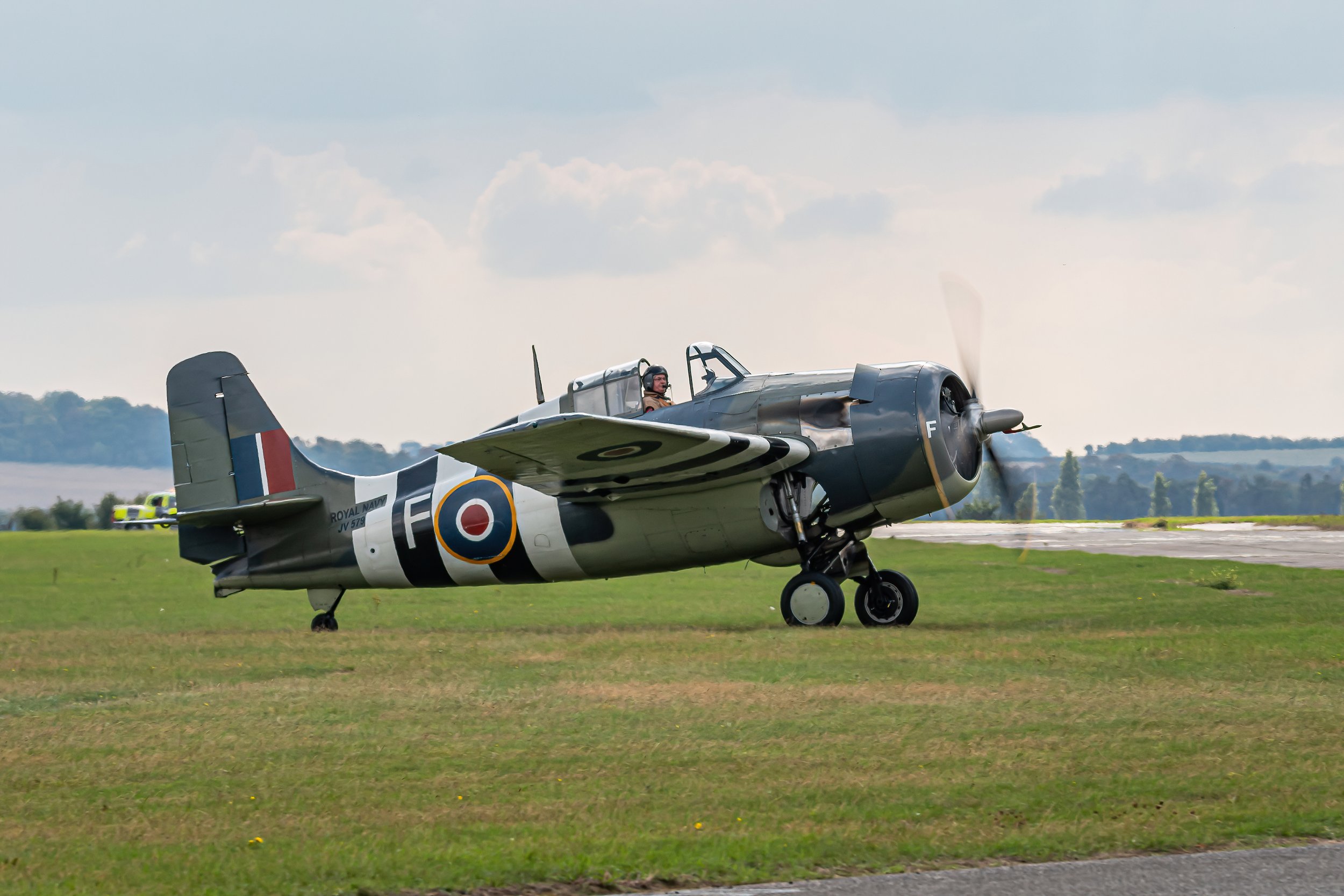
September 2 / Grumman F4F Wildcat first flight
First Flight 2 September 1937
Grumman F4F Wildcat
The Grumman F4F Wildcat is a legendary aircraft that played a pivotal role in the early years of World War II, particularly in the Pacific Theater. Its history is intertwined with the evolution of naval aviation and reflects the challenges and triumphs faced by the United States as it adapted to the demands of modern warfare.
The story of the Wildcat begins in the late 1930s, a period marked by escalating tensions in Europe and Asia. The United States Navy recognized the need for a capable carrier-based fighter to counter the growing threats posed by Axis powers. In 1936, the Navy issued a specification for a new fighter aircraft, which prompted Grumman, a company that had already established a reputation for producing rugged and reliable aircraft, to respond with a design that would eventually become the Wildcat.
Initially designated the XF4F-1, the aircraft was a biplane, but as the design evolved, Grumman transitioned to a monoplane configuration to improve performance. The first prototype took to the skies in 1937, showcasing a design that emphasized durability and ease of maintenance—qualities that would prove essential for carrier operations. The Wildcat was powered by the Pratt & Whitney R-1830 Twin Wasp engine, which allowed it to reach a maximum speed of around 318 mph (512 km/h). The aircraft featured a distinctive appearance with its rounded wings and stout fuselage, which contributed to its nickname, “the Iron Works.”
The Wildcat entered service in 1940, and its first operational deployment came shortly before the United States officially entered World War II. As the conflict escalated, the Wildcat became the primary fighter for the U.S. Navy and Marine Corps, seeing action in critical battles such as the Battle of Midway and the Guadalcanal Campaign. When the Japanese attacked Pearl Harbor on December 7, 1941, the Wildcat was among the aircraft defending the Pacific Fleet. Despite its relatively modest speed compared to its adversaries, the Wildcat’s ruggedness and reliability made it a favourite among pilots.
One of the most significant challenges faced by Wildcat pilots was the formidable Mitsubishi A6M Zero, the primary carrier-based fighter of the Imperial Japanese Navy. The Zero was known for its exceptional manoeuvrability and speed, which posed a considerable threat to the Wildcats. In dogfights, the Wildcat often found itself outmatched in terms of agility. However, U.S. pilots quickly learned that teamwork and tactics could help level the playing field. They employed strategies that took advantage of the Wildcat’s strengths—such as its firepower and durability—while minimizing exposure to the Zero’s superior agility.
The F4F Wildcat was equipped with six .50 caliber (12.7 mm) M2 Browning machine guns, providing significant firepower for its time. The aircraft’s design emphasized ruggedness, and it was not uncommon for Wildcats to return to base with extensive battle damage. This resilience became a defining characteristic of the Wildcat, earning it a reputation as a reliable workhorse in the face of adversity.
As the war progressed, the Wildcat underwent several modifications to enhance its capabilities. The F4F-4 variant, introduced in 1942, featured a redesigned wing and increased armament. This version had four .50 caliber machine guns mounted in the wings, in addition to the two guns in the nose, bringing the total to six. Although the F4F-4 was slightly heavier than its predecessor, the increased firepower was deemed essential for the increasingly tough aerial engagements faced by U.S. forces.
Another significant variant was the FM-1 Wildcat, produced by General Motors under license. The FM-1 featured a slightly larger wingspan and improved performance due to the use of a more powerful engine. This version was designed to be easier to manufacture, reflecting the wartime need for increased production capacity. By the end of the war, over 7,800 Wildcats had been built, making it one of the most produced American fighters of the conflict.
The Wildcat continued to serve throughout the war, participating in numerous battles and campaigns. It was instrumental in the defense of Midway, where U.S. forces turned the tide against the Japanese Navy. The Wildcat also saw action in the Solomon Islands, the Aleutian Islands, and other key locations. Its presence on aircraft carriers like the USS Enterprise and USS Yorktown was vital in establishing air superiority.
As the war progressed and the introduction of more advanced fighters, such as the F6F Hellcat and the F4U Corsair, began to overshadow the Wildcat, the aircraft found new roles. Many Wildcats were repurposed for ground attack missions, while others were used as trainers for new pilots. Despite being outclassed in terms of speed and manoeuvrability, the Wildcat remained a reliable and effective aircraft throughout the conflict.
The legacy of the Grumman F4F Wildcat extends far beyond its combat service. It became a symbol of American resilience and determination during a challenging period in history. Its rugged design and adaptability set the stage for future carrier-based fighters, establishing Grumman as a leading manufacturer in military aviation.
Today, the F4F Wildcat is celebrated in aviation museums and airshows, where it serves as a reminder of the bravery of the pilots who flew it and the critical role it played in securing victory in the skies over the Pacific. The Wildcat’s story is a testament to the innovation and perseverance that characterized the aviation industry during World War II, and it remains an enduring symbol of that era. Its contributions to naval aviation and its place in history continue to be honoured and remembered, ensuring that the legacy of the Grumman F4F Wildcat will not be forgotten.
Wildcat Facts
Design Origins: The Wildcat was initially designed as a naval fighter for the U.S. Navy in the late 1930s. Its design was influenced by Grumman’s earlier aircraft, particularly the F3F biplane, which emphasized ruggedness and reliability.
First Carrier-Based Fighter: The F4F Wildcat was the first carrier-based fighter to be deployed in significant numbers by the U.S. Navy. It played a vital role in early naval battles in the Pacific theatre.
Two Variants: The Wildcat had two primary variants: the F4F-3 and the F4F-4. The F4F-4 featured a more powerful engine and increased armament, including four .50 caliber machine guns compared to the F4F-3’s six .30 caliber guns.
Rugged Construction: The Wildcat was known for its rugged construction and ability to take damage and keep flying. Its design included a reinforced airframe and self-sealing fuel tanks, which contributed to its survivability in combat.
Performance Limitations: Despite its toughness, the Wildcat was outclassed in terms of speed and manoeuvrability by newer Japanese fighters like the A6M Zero. However, its ability to absorb damage and its solid performance in dogfights made it effective in combat.
The “Wildcat” Name: The name “Wildcat” was chosen to honour the wildcat, a fierce and adaptable animal. This name was part of Grumman’s tradition of naming their aircraft after cats, as seen in their earlier models like the “F7F Tigercat” and “F8F Bearcat.”
Role in the Battle of Midway: The Wildcat played a crucial role in the Battle of Midway in June 1942, where U.S. Navy pilots, flying Wildcats, engaged in significant aerial combat against Japanese forces, contributing to a pivotal victory.
Exported to Allies: The Wildcat was not only used by U.S. forces but was also exported to several Allied nations, including the British Royal Navy, where it was known as the “Martlet.” The British utilized the aircraft on their aircraft carriers and land bases.
Training Aircraft: The Wildcat served as a training aircraft for many naval aviators during the war. Its relatively forgiving flight characteristics made it suitable for training purposes, helping to prepare pilots for combat.
End of Service: The Wildcat remained in service until the end of World War II, but it was gradually phased out in favor of more advanced fighters like the F6F Hellcat and the F4U Corsair. Despite this, the Wildcat’s legacy as a tough and dependable fighter endures in aviation history.

























